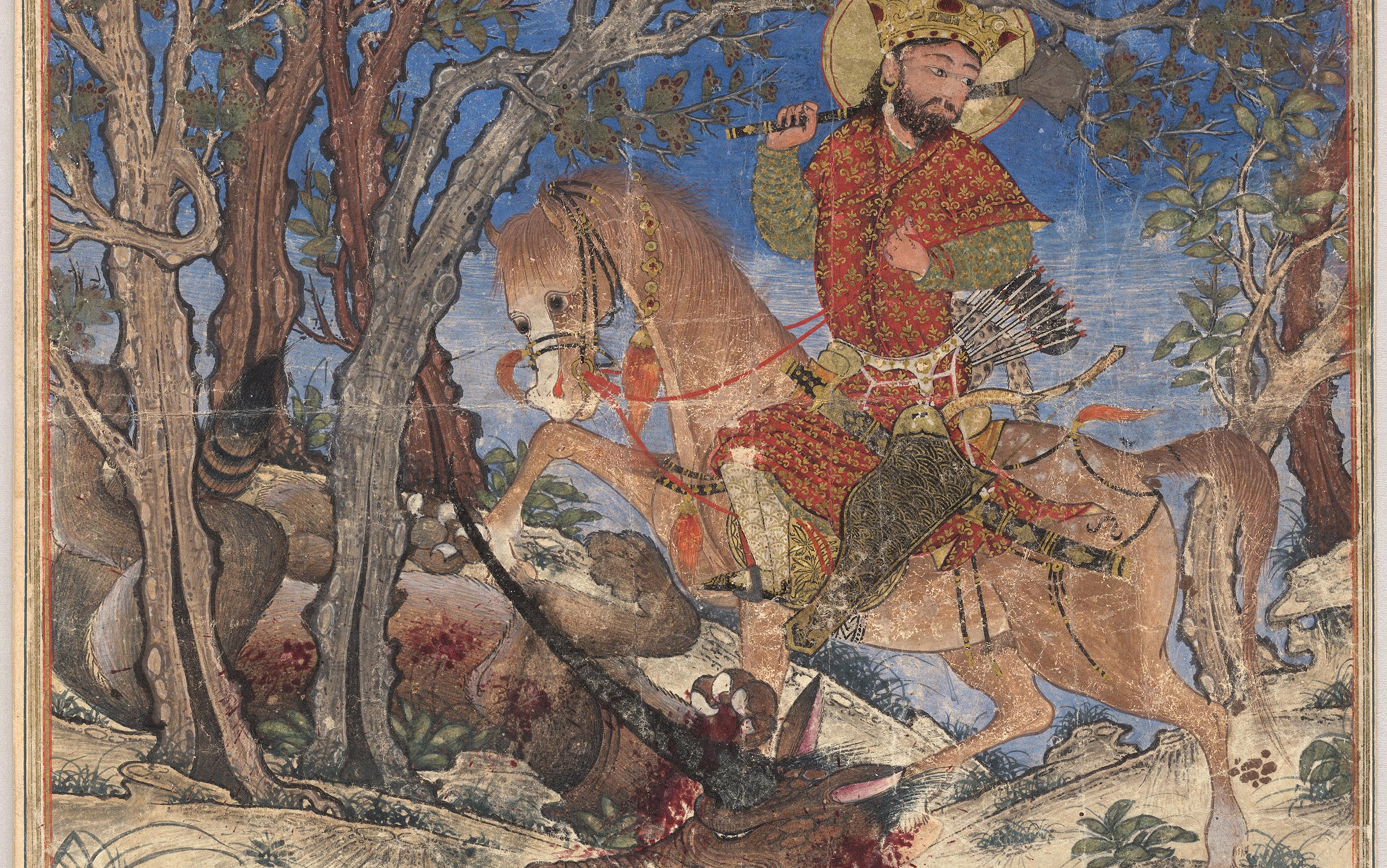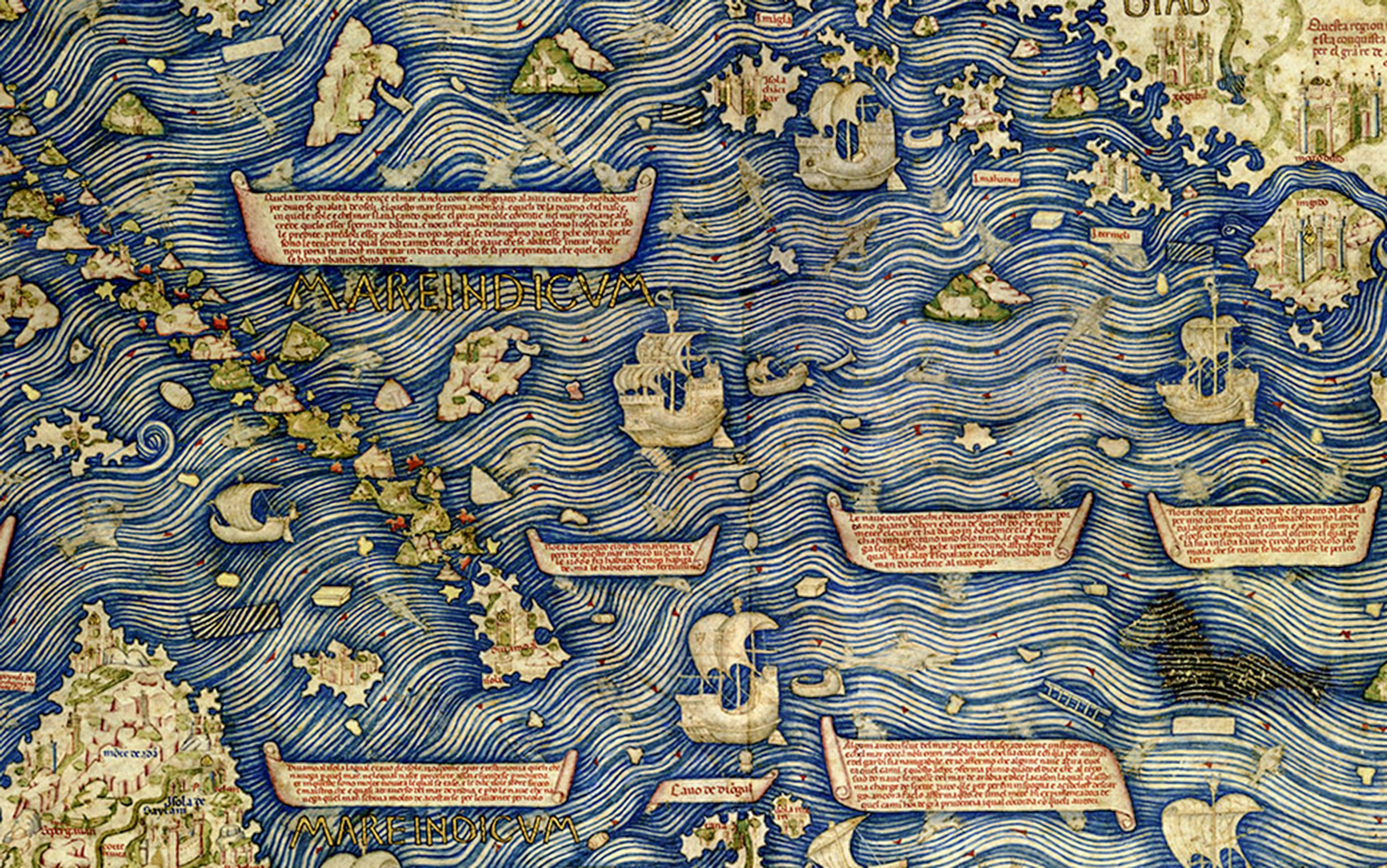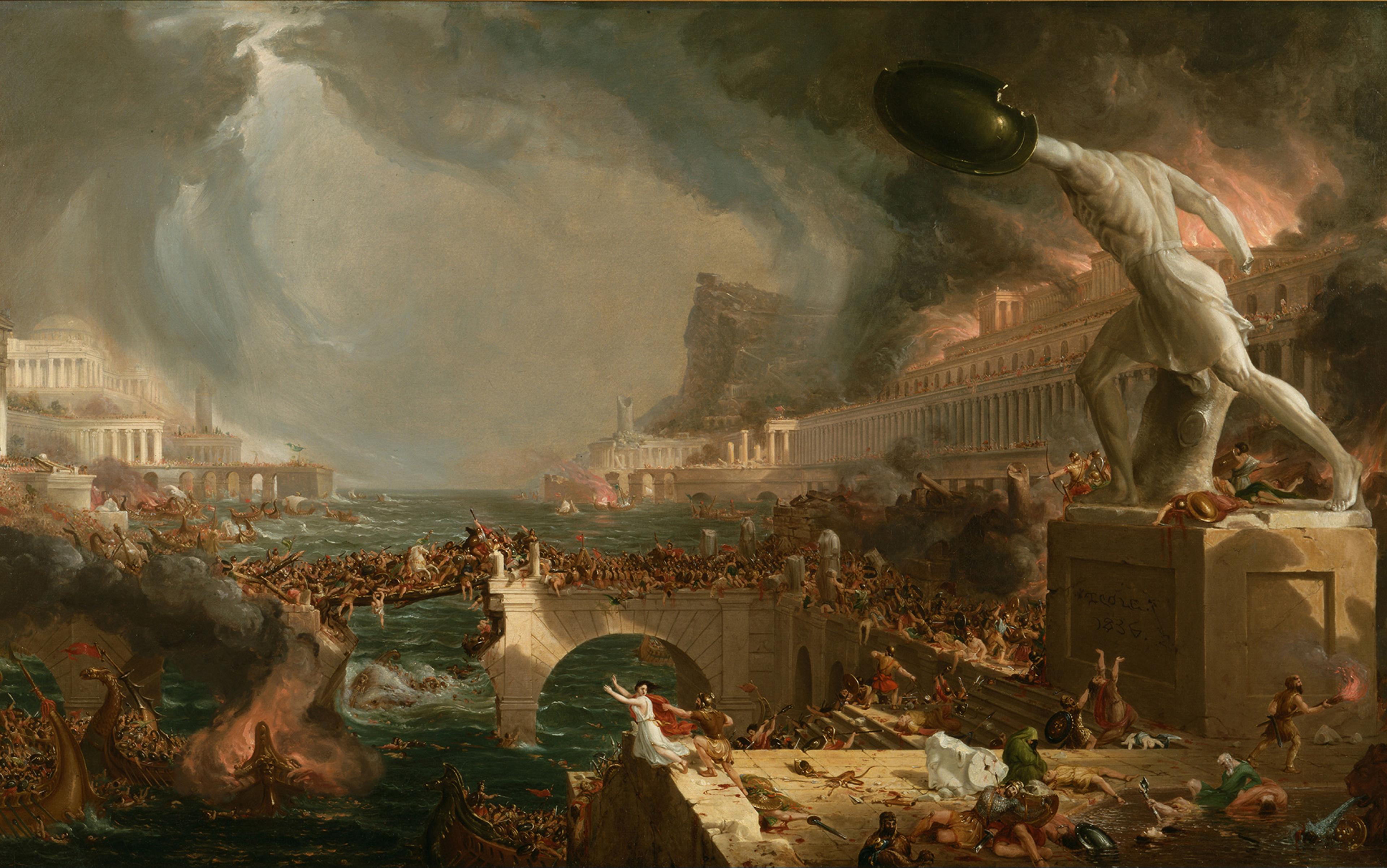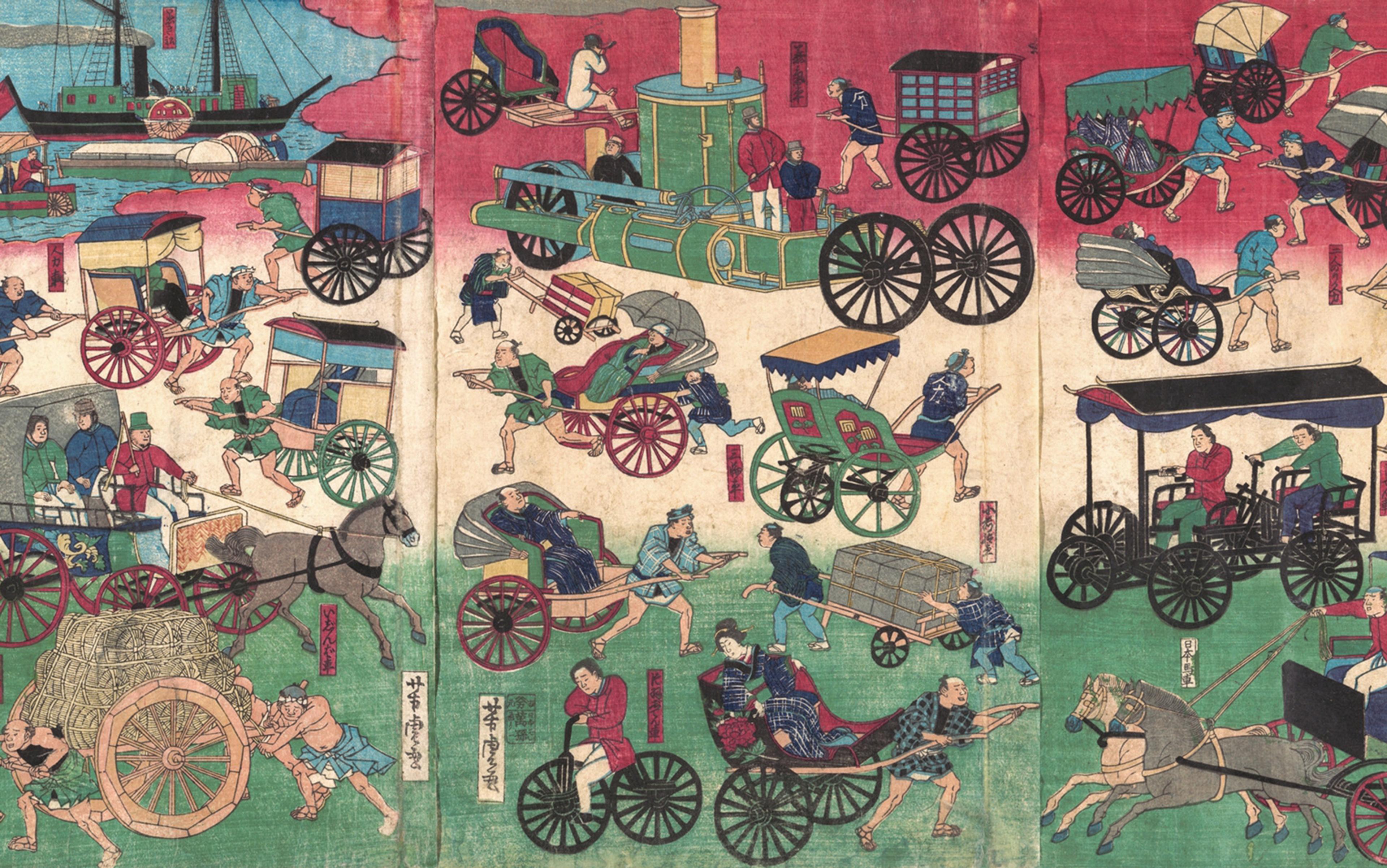The process that gave rise to Eurocentrism in social sciences and history is somewhat comparable to the follies of youth. Little children have difficulty believing that their parents existed before their birth. Teenagers often think that they are the first ones to have the experiences they are having as they make their way into adulthood. Young people usually think of previous generations as stodgy and old-fashioned, and of themselves as uniquely special and innovative. And they imagine they will be forever so, as if time will stop moving after them.
Part of growing up, however, is gradually breaking out of such narcissistic naiveté. As we get older, we start realising that others before us had many experiences that resemble ours, even if they enjoyed different fashions and lacked certain technologies. Then the cycle repeats with the next generation. It is perhaps not particularly surprising that our social sciences, which came of age in the 19th and early 20th centuries – ie, ‘the youth’ of European/Western hegemony – also had a similar naiveté about world history. Europe/the West mattered the most at that moment, so it must have always been so. And perhaps it is a sign we are now nearing the twilight years of this hegemony that critiques (and self-critiques) of Eurocentrism have become so commonplace in most social sciences as to be banal.
But while it has been easy to level critiques of Eurocentrism against the social sciences – a low-hanging fruit if there ever was one – it has proven much harder to find solutions to it. There is always the danger that, in attempts to get away from Eurocentrism, we replace one kind of self-regarding history with another. It is also naive to think that only Europeans produce/have produced self-centred and whiggish narratives of history. A Sinocentric or Russocentric world history is no solution – it would just repeat the cycle.
So how do we do it?
In international relations, too, until recently, students were taught that there was no international order (and thus no international relations) until the 17th century, until Europeans created a regional order via the Westphalian Peace in 1648 and then expanded that around the world. The rest of the world was assumed to be disconnected, stuck in their regional silos, uninterested in the wider world, until European actors connected them first to Europe, and then to each other.
In such textbook accounts, ‘international order’ is usually defined as referring to the system of rules, norms and institutions that govern relations among states and other international actors. The principles and norms that underpin the modern international order are considered to include sovereignty, territorial integrity, human rights, non-interference in internal affairs, peaceful settlement of disputes, multilateralism and the rule of law. Westphalia is considered the origin point because of its supposed introduction of the non-interference principle.
There is plenty of international relations material in history outside of Europe and before modernity
The ‘Westphalian myth’ in international relations has come under considerable criticism in recent years, but given the way international order is traditionally defined, it is not particularly surprising that experts maintain that there were no comparable international orders before our modern one (though it is also questionable how long such an order has existed even in modernity). The problem stems from the fact that our terminology grabs some features of world politics that have existed only in modernity (eg, the concept of human rights, international organisations, or even territorial integrity) and builds them into the definition with other features that have arguably been around much longer (eg, sovereignty or mechanisms for peaceful settlement of disputes). Even the term international order is misleading because it presumes nation-states, which are a relatively late feature of human politics.
But if we relax the assumption that only orders created by nation-states are worth studying, then there is plenty of international relations material in history outside of Europe and before modernity that we can investigate. This is why I prefer to speak of ‘world orders’ instead of ‘international orders’, defined as the (man-made) rules, understandings and institutions that govern (and pattern) relations between the primary actors of world politics (but those actors can change over time: nation-states, aristocratic houses, city-states, etc). A ‘world order’ also has a universalising ambition at its core and is expansive in its vision.
When we think of it that way, it is not hard to see that there certainly were world orders before Westphalia and the 17th century: ‘the East’ too has been home to world orders (and world orderers). By looking at Asian world orders that came before European hegemony, we can learn a great deal.
There was a ‘Chinggisid’ world order as created by Genghis (Chinggis) Khan and members of his house (13th-14th centuries), followed by the ‘post-Chinggisid’ world order of the Timurids and the early Ming (14th-15th centuries) and, finally, a globalising world with its core position occupied by three post-Timurid (and, therefore, Chinggisid) empires (15th-17th centuries): the Ottomans, the Safavids and the Mughals (along with the Habsburgs). These orders were also linked to each other just as our contemporary order is linked to the 19th-century international order – there was a continuity in their shared norms. In each of these periods, the world was dominated and ordered by great houses who justified their sovereignty along Chinggisid lines.
‘Chinggisid’ sovereignty means the following: in the 13th century, Genghis Khan reintroduced to Eurasia a type of all-powerful sacred kingship we associate more with antiquity but one that had disappeared from much of this space after the advent of monotheistic religions and transcendental belief systems that checked the earthly power of political rulers by pointing to an all-powerful moral code that applied to all humans. As such religions gained more power from late antiquity onwards, the power of kingship was greatly diminished throughout Eurasia. Kings could no longer make laws as they had to share their authority with the written religious canon and its interpreters. Genghis Khan and the Mongols broke this pattern of constrained kingship (others had attempted to do so before as well, but never so successfully). The adjective Chinggisid is more apt than Mongol to describe the worlds thus created because these orders were orders of great houses (dynasties) rather than nations.
Such absolute rulers always chased world empire and ended up ordering the world
Genghis Khan claimed law-making power above and beyond that of religious (and other) actors. He made himself the lawgiver but did not claim to be a prophet. Nor did he claim to be merely verbalising divine laws. He made the law and still expected people to obey, even if they already had their own religious rules and laws. Such centralisation of supreme authority in one person requires robust legitimation. The claim to have such awesome authority could be justified only by a mandate for universal sovereignty over the world, as corroborated and manifested by world conquest and world empire. And because Genghis Khan succeeded in creating a nearly universal empire, he also diffused this particular understanding of sovereignty across Eurasia.
The story of Genghis Khan as a world-conqueror and lawgiver lived on for centuries (as inflected by the example of Timur/Tamerlane later), legitimising a certain type of political rule throughout this space and strengthening the hands of rulers desiring to claim centralising political authority, even in places where religious authority (eg, the Islamic jurists) posed a challenge to absolute kingship. And such rulers always chased world empire and ended up ordering the world (often violently and brutally but also at times productively) in their competition for this mantle. The Asian world orders between the 13th and 17th centuries constitute an important history of powerful and influential world orders outside of European hegemony. And insofar as political centralisation is an essential component of modern sovereignty, it may be argued that similar Asian understandings and practices of sovereignty both predate and may have even influenced the European trajectory.
First was the original ‘world order’ created by Genghis Khan (and his house) in the 13th century. If there is indeed an ‘East’ that is distinct from the ‘West’, one of the points of separation can be placed here. After all, Genghis Khan’s empire was primarily an ‘Asian’ one, spanning the distance from the Pacific Ocean in the East to the Mediterranean in the West. Actors of (and within) this order interacted with the Indian subcontinent to their South and the European/Mediterranean regional orders to their West (and influenced developments therein and vice versa) but, for the most part, polities in those regions were not incorporated into this order and retained their own logics of power, legitimation, warfare, etc.
In this ‘Asian’ order, people living in the geographies that we now call ‘Russia’, ‘China’, ‘Iran’ and ‘Central Asia’ – basically, most of continental Asia – shared the same sovereign for the first time and then were ruled/dominated by dynasties (the Golden Horde/Jochid, the Yuan, the Ilkhanate and the Chagatai) that directly inherited Chinggisid norms, ie, ambitions of universal sovereignty and dynastic legitimacy based on world conquest, high degrees of political centralisation around the supreme authority of the Great Khan. They were also significantly connected to each other through overland and naval routes that spanned the entire continent, as well as the Indian Ocean.
The existence of such trade routes – the ‘silk roads’ – predated the Chinggisid Empire. After their conquests, however, the Mongols strengthened these connections through the postal (yām) system and homogenised the points of contact throughout by their presence in the major spheres of influence within the continent. Thus, late 13th-century Eurasia was as connected as it had ever been (and even more so than some subsequent periods). Famous explorers of the 14th century – eg, Marco Polo or Ibn Battuta – could thus make their way from Europe or North Africa to China with relative ease, causing hardly any more commotion than some curiosity among hosts (who must have been accustomed to travellers along these routes) and facing not much more than some demand for updated information about cities and rulers encountered along the way.
The spread of the Black Death from the East in the mid-14th century spelled the end of that status quo
Yet others travelled in the opposite direction from China to West Asia, and started new lives in Europe or what is now called Iran, under new rulers. A mostly forgotten aspect of this order is the facilitation of epistemic exchange of all sorts, most notably between ‘Iran’ and ‘China’: in the 13th and 14th centuries, bureaucrats, scientists, artists, craftsmen and engineers could be born on one side of Asia and finish their careers on the opposite side, with profound implications for artistic, cultural and scientific standards of both societies. The best (but not only) example of this cultural exchange is the fundamental transformation of Islamic art from the 13th century onwards under Chinese influences, producing among other things the blue-and-white ceramics that are now so closely associated with the Middle East. This process is sometimes called the ‘Chinggisid exchange’ by historians of the Mongol Empire, similar to the Columbian exchange in terms of its world-historical impact.
After holding most of Asia under the same sovereign for more than half a century – which would be no small feat even today, let alone in the 13th century – the world empire/khanate ruled by the Great House of Genghis Khan fragmented into four smaller khanates, each based in territories originally given to different branches of his descendants to govern. Once autonomous, rival khanates went through a brief period of intense fighting to reclaim the mantle of universal sovereignty, but none managed to dominate the others. Eventually they settled into a ‘balance-of-power’ type equilibrium in the early 14th century. This period was particularly good for overland trade across Eurasia, extending the period known as Pax Mongolica.
The spread of the Black Death from the East (or Central Asia) to the West in the mid-14th century spelled the end of that status quo, however, as all but one of the khanates fell apart. The Golden Horde continued to rule the north-western steppes of Asia (present-day Russia), but the Chagatai Khanate (Central Asia) and the Ilkhanate (the Middle East) disintegrated, eventually giving way by the end of the 14th century to the Timurid Empire originating from Transoxiana, and the Yuan were overthrown by the Ming dynasty in 1366. Thus ended the first would-be world order organised by Chinggisid sovereignty.
The next world order that succeeded Genghis Khan’s and its successor khanates brought more diversity, and a competition between two great powers. From the last third of the 14th century to the middle of the 15th century, the Great Houses of Timur (Tamerlane) and Zhu Yuanzhang (Hongwu), ie, the Ming dynasty, competed to succeed the Great House of Genghis Khan from the two sides of Asia.
As long as the Ming and the Timurids competed, they ordered the world in post-Chinggisid ways. They were post-Chinggisid because neither the Timurids nor the Ming were directly linked to the house of Genghis Khan but were nevertheless very much influenced by the order of their predecessors. They had different views about the Chinggisids but, just as in our modern world, one cannot escape an institutional legacy only by rejecting its creators.
The post-Chinggisid influence is easy to demonstrate in the case of the Timurids because Timur, as a Turco-Mongol ruler himself, did his best to play up any connections. He married a Chinggisid princess. He ruled through a puppet khan from a Chinggisid lineage, never taking the title for himself (he was called amir himself). Still, in all ways that mattered, he deliberately fashioned himself after the model of Genghis Khan and died on the way to attempting to conquer China, just like Genghis. He centralised authority in the Chinggisid mould, seeking world conquest and recognition. He even found a novel way to reconcile the tension between Chinggisid sovereignty and Islam via the title of sahibkıran (Lord of Conjunction), as astronomy/astrology was a bridge between the Chinggisid and Islamic ways of seeing the world.
By contrast, the Ming, who were Han, ostensibly rejected any Chinggisid influences after they overthrew the Yuan dynasty. Still, the preoccupation of the early Ming emperors Hongwu and Yongle with world recognition also demonstrably derived from Chinggisid ideals and thus can be considered post-Chinggisid. In 1403, the Ming emperor ordered the construction of 137 ocean-going ships; later, he ordered the construction of 1,180 more. He put Zheng He in charge of these expeditions which went as far as the Indian Ocean. Modern-day China’s power-projection ambitions have reintroduced these so-called ‘Ming treasure voyages’ to the popular imagination.
Overland trade brought Ming wares to West Asia (which then sold them to the Middle East and Europe)
However, what is often missed in contemporary discussion is the larger context and historical antecedents of these voyages. The maritime envoys were only part of the story – Yongle also sent overland envoys, including to Herat, the Timurid capital. Even experts in the growing field of China’s historical international relations often overlook the degree to which the goal of external recognition drove the early Ming and how that ideal derived from their Yuan (Chinggisid) predecessors and was shared by Central Asian rivals. Much of international relations scholarship, with its bias for a 20th-century world, still imagines inner Asia to be peripheral to world politics in history. But in the 15th century, it was the centre of a world ordered by the Timurids on the one side and the Ming on the other.
Timur failed to conquer China and eventually he had to settle into something like mutual recognition with the early Ming dynasty. A continent of lesser houses connected the great houses of Timur and Yuan or Ming. Some had their own Chinggisid-style world-empire aspirations, and others, the Joseon dynasty in Korea, for example, operated at a minimum with an understanding of the same Chinggisid legacy. Material connections were also part of the legacy of the Chinggisid world order, across Asia. Overland trade brought Ming wares to West Asia (which then sold them to the Middle East and Europe) and silver to the East. Both the Timurid and the Ming also sponsored great works of art and craftsmanship in this period.
Some may object that direct contact between these two Great Houses on the two sides of Asia was infrequent and therefore not enough to constitute a world order. But there is a resemblance between the order of the Timurids and the Ming in the late 14th/early 15th century, on the one hand, and that created by the rivalry of the US and the USSR after the Second World War, on the other. In both orders, one pole downplayed or even ostensibly rejected the legacy of the former world order whereas the other embraced it. But both were products of a shared historical experience and in fact had a lot in common in how they saw the world. Even when the Timur and Ming dynasties did not directly interact, they competed with each other symbolically and in so doing reinforced the normative fabric of the 14th- to 15th-century world order in Asia.
Also like the Cold War order, the Timurid-Ming rivalry was not around for very long. In the middle of the 15th century, a bullion famine, a shortage of money, hit Eurasia and precipitated a period of structural crisis by contracting overland trade. The Timurid dynasty of West Asia was particularly hard hit. The Timurids lost control over their territories. In the second half of the 15th century, Chinggisid influences on the Ming also faded, and neo-Confucianism took over. The neo-Confucian movement empowered bureaucrats and officials and constrained the power and authority of the Ming rulers, checking centralisation. The Ming realm turned more inward-looking, or isolationist. The ‘bipolar’ world order of the Timurid and the Ming Great Houses fragmented before it had the opportunity to congeal into something more institutionalised.
The next fertile ground for world-ordering projects based on Chinggisid sovereignty norms came from the southwestern corner of Asia. In the 15th century, the region had been dominated by the Timurid Empire/khanate, and Chinggisid sovereignty norms had merged with existing Persian notions of kingship, millennial expectations, astrology and other occult sciences, as well as folk practices of Islam within this region. This fusion of Chinggisid, Persian and Islamic political cultures gave rise to at least three great houses with some of the more ambitious universal sovereignty claims in history: the Ottomans, the Safavids and the Mughals.
By the 16th century, these three Great Houses together claimed sovereignty over more than a third of the human population of the world. They also controlled the core of the world economy. Though often called Islamicate empires, the Ottomans, the Safavids and the Mughals shared more than Islam (and at times contravened prior Islamic practice). As with the previous examples discussed, they too subscribed to the same sovereignty model (at least in the 16th century): a type of sacred kingship, a fused form of vertical political centralisation achieved by the unification of political and religious authority in the same person, made possible by the Chinggisid-Timurid legacies they inherited. Following Timur, the Ottoman, Safavid and Mughal claim to greatness was based on the claim of the rulers from these houses to be sahibkıran, universal sovereigns marked by signs from the heavens, living in the end of days, delivering on millennial expectations. Astrology and other occult sciences supported the universal sovereignty projects of these would-be world empires. Thus, in the 16th century, it was primarily the post-Chinggisid and post-Timurid ‘millennial sovereigns’ in Southwest Asia who ordered an increasingly globalising world, not yet the Europeans.
Scholars of international relations tend to see the 16th century as holding the seeds of a world order based on European hegemony. It is undeniable that the 16th century was a period of growth and expansion for Europe (especially for Habsburg Spain), but Europe was growing from a position of greater deprivation than Asia. If we do not read the ending of the story back into the historical narrative, in the 16th century it was still not at all obvious that European actors would come to dominate the world. Almost all histories of this period within international relations treat the Habsburgs’ eastern relations as relatively insignificant, but that is also a projection of the standards of a later time to the 16th century. Especially in the first two-thirds of the 16th century, the main rival of the Habsburgs were the Ottomans, who were themselves engaged in a simultaneous rivalry with the Safavids, from whose orbit the Mughals were trying to break. Smaller European houses had aspirations, to be sure, but their time in the sun had not really come yet, and they initially had to rely on Eastern alliances as well as trade with Asia to get on an upward trajectory.
No region is ‘destined’ to order the world; outcomes are not just path-dependent but also contingent and variable
All of this is to say that we must scrap the traditional narrative lurking in the background of the Westphalian origin myth of international relations, ie, the narrative of an ascendant European order in the 16th century with non-European hangers-on looking in, such as the Ottomans on its periphery (or the Russians). The real picture is just the opposite: the 16th-century world had a core of post-Timurid empires in (south-)West Asia animated by an intense competition focused on universal sovereignty, and European actors such as the Habsburgs were trying to challenge the dominance of that core (while other European players linked into it through trade networks and other alliances). The Ming still had to contend with Mongol warriors on their frontiers, motivated by these same notions; in the northwest, Muscovy had been remade in the image of the Golden Horde. The various peoples of Inner Asia also mostly operated with Chinggisid sovereignty norms still, even if the expectations around centralisation and world empire remained only aspirational. The 16th-century world was thus still very much ordered from the East. It is important to realise this because it disrupts our teleological thinking about the inevitability of European hegemony. No region is ‘destined’ to order the world; outcomes are not just path-dependent but also contingent and variable.
The expansion of this Eastern world order was stopped in its tracks not by destiny or European greatness, but rather by the unpredictable developments of the late 16th to mid-17th century, a politically tumultuous period throughout Eurasia. Some historians label this period ‘the 17th-century general crisis’, a period of prolonged rebellions, civil wars and demographic decline throughout the northern hemisphere. Historians have given different explanations as to what ushered in this upheaval: some suggesting financial causes (eg, the global repercussions of the Spanish ‘price revolution’ – inflation – due to the influx of surplus silver from the New World), whereas others point to demographic contraction. Others now link the chaos of this period to the Little Ice Age: the peak moment of a cooler period in the Northern Hemisphere that extended from the 13th to the 19th century. Prolonged periods of cooler temperatures and storms may indeed have been responsible for all the other factors we associate with the period: crop failures, disruption of overland trade, demographic collapse in hinterlands, rebellions and civil wars.
Whatever the cause, the continued disorder of the 17th century caused the irreversible fragmentation of the 16th-century world order. This was the turning point for the East because, while aspects of the Chinggisid sovereignty norms survived the 17th century and motivated particular rulers (eg, Nader Shah of Persia), no new ‘world orders’ organised around those norms were successfully created after the 17th century. A global perception set in the 19th century that Asia had been irreversibly declining for centuries, even though most Asian and Eurasian states had materially recovered from the crises of the 17th century, and had, in some cases, even gone on to territorially expand in the 18th century (eg, Russia, China). These two developments – the loss of ‘world orders’ originating in the East, on the one hand, and the perception of decline despite continued durability of Eastern states, on the other – are linked.
One of the greatest benefits of moving beyond Eurocentrism and thus having more examples outside of European history to think with about our present challenges is that such examples expand our imagination as to what is possible. Until recently, international relations scholars had imagined that international orders do not change very much in terms of their building blocks – it was assumed that only the number or the identity of great powers changed. Until recently, international relations also did not allow for the possibility that the liberal international order may unravel or be replaced by an entirely alien order (in a similar vein to the ‘End of History’ thesis of the 1990s). Such conclusions are somewhat inevitable if one looks at the world only post-17th century. But world history teaches us different lessons.
When we study the trajectory of Eastern world orders, we see that structural crises punctuate the end of each order (even if the exact chain of causality is hard to ascertain). The fragmentation of each Eastern world order seems to at least correlate with a ‘general crisis’ that affected large areas of the Northern Hemisphere. The original Chinggisid world order fragmented at a time when the plague was spreading across Asia (and then Europe) and came to an end during a period that some historians label ‘the 14th-century crisis’; the post-Chinggisid world order fragmented during a period some historians call ‘the 15th-century crisis’, the effects of which seem to have been felt especially in west Asia and Europe.
The 17th-century crisis period of fragmentation lasted the longest and spelled the end of Eastern world orders
Longue durée hindsight allows us to see that political turmoil during these crises (and during the ensuing fragmentation of the existing order) was not really caused by specific great house rivalries or ‘power transition’ (ie, the things international relations most worries about as being corrosive to order), but rather structural dynamics such as climate change, epidemics, demographic decline, monetary problems etc: ie, the things international relations has not worried about at all until recently. Contrary to the assumptions of the international relations literature about great powers, this history suggests that rivalries by great houses that shared the same understanding of ‘greatness’ in fact strengthened and reinforced the existing world order (even when those rivalries turned violent).
A similar observation can be made about great power competition in the 19th century or the Cold War. Rivalry is constitutive of order (almost as much as trade and cooperation); order decline almost always originates from elsewhere. A final observation is that world orders were not immediately replaced after fragmentation; there were periods without ‘world order’-ers around (or, even if they were around, their presence was not felt by other actors). The 17th-century crisis period of fragmentation lasted the longest and perhaps for that reason spelled the end of Eastern world orders.
Unfortunately, there are enough reasons to suspect that we may be in for a similar period of turbulence and disorder in the 21st century. All the factors that were at play in the 17th century – climate change, demographic unpredictability, economic volatility, internal chaos – that took the attention of world orderers from maintaining world order are also present today.
This Essay is based on the chapter ‘What Is the East?’ of the author’s book Before the West (2022) published by Cambridge University Press.






